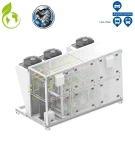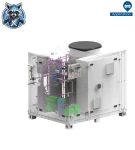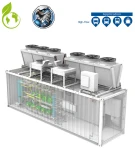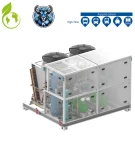- What is the main function of a hydrogen cooling system and why is it so important?
- What types of hydrogen cooling systems exist?
- What is special about cooling hydrogen at refueling stations?
- What are the key performance criteria of a hydrogen cooling system?
- Which are the key interfaces to other components in a hydrogen refueling station?
- Sizing of hydrogen cooling systems
- How does the amount of hydrogen filled during a dispense affect the size of hydrogen cooling system? Differences between light duty vehicles and heavy-duty vehicles.
- Do modern hydrogen cooling systems monitor the design effectiveness of cooling system sizing and can it be adjusted?
Browse all hydrogen coolings systems from leading suppliers on our marketplace!
What is the main function of a hydrogen cooling system and why is it so important?
A hydrogen cooling system is necessary so that hydrogen-powered cars can be refuelled quickly. Due to the Joule Thomson Effect and hydrogen compression in the hydrogen car’s storage tank, the hydrogen would heat up above the maximum permissible temperature of the hydrogen storage in the car tank at a high mass flow. For this reason, the hydrogen is cooled down to, for example, -33°C to -40°C (T40 protocol) shortly before it reaches the car. This keeps the tank temperature in the car below the maximum permissible temperature of about 85°C. With the help of the cooling system, refuelling is possible within 5 minutes.
What types of hydrogen cooling systems exist?
Basically, a distinction can be made between active and passive hydrogen cooling. Active cooling is then further subdivided into direct and indirect cooling.

Methods of H2 Cooling
- Direct cooling uses a diffusion-bonded heat exchanger to cool down hydrogen (most common at present).
- Indirect cooling uses a cooling medium such as a water/glycol mixture as an intermediate medium to cool down the hydrogen (not recommended due to inefficiency).
- Passive cooling uses a hydrogen heat exchanger with a high thermal mass, allowing the refrigeration system itself to become smaller (recommended for low B2B fillings with cars).
You can find a comparison table of hydrogen cooling possibilities below:

H2 Cooling Types
What is special about cooling hydrogen at refueling stations?
When cooling hydrogen at hydrogen filling stations, attention must be paid to the explosion area around the dispenser. Here, the components must be selected accordingly. Since the refrigeration system is usually located at a distance of approx. 20-40m, conventional components can be used here.
Furthermore, the control of the system must be designed in such a way that it can react quickly to strong power fluctuations. This ensures that the hydrogen outlet temperature remains within the temperature window.
What are the key performance criteria of a hydrogen cooling system?
The most important point is the system cooling capacity itself. This in turn depends on the type of hydrogen cooling. If a large number of B2B (Back to Back) refuellings are to be carried out in succession or a big amount of hydrogen is fuelled in one fuelling, a direct cooling system should be used. This system requires a higher connection load, but also provides a higher cooling capacity during refuelling. During the breaks between refuelling, on the other hand, the power consumption will be very low.
Which are the key interfaces to other components in a hydrogen refueling station?
The interface between the refrigeration system and the hydrogen filling station is always the hydrogen heat exchanger, which is usually located inside or next to the dispenser.
Sizing of hydrogen cooling systems
In general, the size of the refrigeration system depends on the type of cooling. Here, a distinction is made between three possibilities.
- Direct cooling by means of a diffusion-bonded heat exchanger (most common at present).
- Indirect cooling, which uses a cooling medium for example water/glycol mixture as an intermediate medium (not recommended due to inefficiency).
- Passive cooling, which uses a hydrogen heat exchanger with a high thermal capacity, allowing the refrigeration system itself to be more compact (recommended for low B2B fillings or low amount of hydrogen fueling with cars).
You can find more information on sizing of cooling systems in the table 1 above.
Which are the key criteria that are relevant for sizing of hydrogen cooling systems?
The key for sizing a hydrogen cooling system is:
- The required temperature category. T40, T30, T20, or an individual hydrogen outlet temperature
- Refuelling pressure H70 (700 bar), or H35 (350 bar)
- Maximum mass flow of hydrogen in g/s during a refuelling procedure
- Average mass flow of hydrogen in g/s during a refuelling procedure
- Amount of hydrogen to be refuelled per hour and per fuelling
- Number of dispensers
- Maximum H2 inlet temperature into the H2 heat exchanger
- Minimum and maximum ambient temperature
- Requirements for the refrigerant e.g. GWP (global warming potential) limitations
- Amount of B2B (Back to Back) refuelling
- Distance between chiller and dispenser
- Country of system installation
How does the size of the hydrogen refueling station effect the size of the hydrogen cooling system?
The size of the cooling system depends in the broadest sense on the number of B2B refuelling events carried out in succession, the maximum amount of hydrogen dispensed per refuelling, and the number of dispensers available for refuelling at the same time.
There are different types of hydrogen cooling systems. The most recommended ones are direct cooling and passive cooling.
When using a passive cooling system, the refrigeration system is small in comparison to direct cooling, as some cooling capacity is stored in the heat exchanger with high thermal mass during refuelling. With this variant the refrigeration system keeps the large heat exchanger at a constant low temperature suitable for the fueling temperature protocol, for example -40°C for T40 protocol. This system is suitable for a small number of B2B refuellings of cars. The amount of hydrogen that can be filled during a refuelling event is limited depending on a calculation.
The situation is different with direct cooling systems. Here, the refrigeration system delivers the cooling capacity instantly to the hydrogen mass flow via a diffusion-bonded heat exchanger.
However, if the requirement is to refuel heavy-duty vehicles such as buses or trucks, which have a much larger hydrogen storage tank, a direct cooling system is recommended. A major advantage of direct cooling is the compact diffusion-bonded heat exchanger, which usually can be easily accommodated in the fuel dispenser. In addition, direct cooling makes it possible to provide a constant cooling capacity over a long period of time.
It is possible to connect a refrigeration system with several dispensers. Depending on the requirement, whether all dispensers are to be in operation at the same time or not, this determines the size and cooling capacity of the refrigeration system. If two dispensers are to be in operation at the same time, twice as much cooling capacity is required.
This illustration shows a model of a hydrogen filling station with a passive cooling system:

Cooling System as part of a hydrogen fueling station
How does the amount of hydrogen filled during a dispense affect the size of hydrogen cooling system? Differences between light duty vehicles and heavy-duty vehicles.
For light vehicles like cars, all three types of cooling can be used. However, only direct cooling and passive cooling are preferred, as indirect cooling is less efficient. The decision whether to use direct or passive cooling then depends only on the number of B2B refuellings.
- With a high number of B2B refuellings => direct cooling
- With a low number of B2B refuellings => indirect cooling
For heavy-duty vehicles, direct or indirect cooling is possible, while direct cooling is clearly favored here due to its better efficiency.
Do modern hydrogen cooling systems monitor the design effectiveness of cooling system sizing and can it be adjusted?
The system is basically designed for one operating point. However, the system intuitively adjusts the cooling capacity to the prevailing hydrogen flow. The cooling capacity can be adjusted down to 0 kW.
Content contributed by Kustec
KUSTEC, officially named as Kälte- und Systemtechnik GmbH, is based on the outskirts of Vienna, in Freundorf, Austria, where all the innovation happens, while an office is located in Colorado, USA. Since 2008, KUSTEC provides hydrogen cooling solutions for a total of more than 250 Hydrogen Refuelling Stations across the globe. Worldwide partnerships allowed excellent customer support. Our motivation is to customize hydrogen cooling solutions to fulfil hydrogen station needs, innovate highly efficient systems with low energy consumption and focus on developing systems with low Global Warming Potential. Before delivery, every system is tested under extreme conditions to ensure it delivers the designed criteria.
Last update: 15.01.2023








